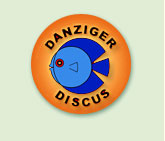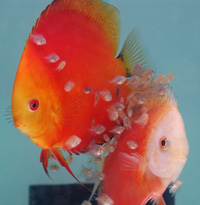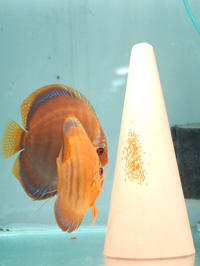
 |
|
Discus Reproduction
 The high point of growing discus is during the reproduction stage. To see a discus pair with tens to hundreds of small little fish feeding from their parents is a spectacular sight.
The high point of growing discus is during the reproduction stage. To see a discus pair with tens to hundreds of small little fish feeding from their parents is a spectacular sight. To reach this stage several steps should be taken: First, establishing a group: It is very difficult to know the gender of a discus especially if it hasn't reach maturity, therefore, it is advisable to put a group of discus in an aquarium (the bigger the group the better the statistical chances of having pairs). It is recommended that the group of discus are of same size and more or less the same age (according to the experience we have gained here at 'Danziger - Discus' the big and dominant fish are usually the males, and therefore, also a few smaller fish should be chosen for the group, assuming they are the females). As the discus reach puberty at about 10-24 months, territory battles and splitting into pairs begin. At this point it would be advisable to place in the aquarium equipment for egg laying such as - cones, plastic tubes, flowerpots, leaves and etc. In the event that a pair is spotted after at least one laying, it is then advisable to transfer the pair on the way to the next laying in a reproducing aquarium, so as to enhance the chances of the baby fish to survive. The recommended size for this reproducing aquarium is 50*60*50 (150 liters gross). The conductivity level should be reduced to  a range of 250-500 micro siemens (see water conditions in the beginning of the article). Conductivity level is reduced by the inverted-osmosis system. It is also advisable to use a sponge filter that is activated by air lift without the use of pumps or power heads in order not to harm the small fish, and of course, to put convenient laying equipment so it will be easy for the female fish to lay the eggs. When at last the moment we have waited for arrives, and the eggs have been laid, the pair should be identified and their gender explored by looking at their anal fin. The female has a wider sex organ through it the eggs are laid that stick to the surface of the laying equipment. The male has a more limited / specific sex organ, as small as a hairpin. The Male fertilizes the eggs at the very same time when the female that laying the eggs.  The eggs hatch after about 60 hours and they stay attached to the laying surface for another 60 hours until they have digested the egg protein and begin swimming independently in search of their parents. Reducing the water level and removing dark objects from the water will make it easy for them to find their parents. Normally, the fish have no problem in finding their parents even if these changes are not made.
The eggs hatch after about 60 hours and they stay attached to the laying surface for another 60 hours until they have digested the egg protein and begin swimming independently in search of their parents. Reducing the water level and removing dark objects from the water will make it easy for them to find their parents. Normally, the fish have no problem in finding their parents even if these changes are not made.After about 7-10 days it is possible to begin feeding the fishy (that still linger on their parents) with fresh Baby Brine Shrimp that has just hatched (up to 24 hours after the Baby Brine Shrimp hatches - its nutritive value is then at its peak). Moreover, it is possible to feed with crushed powdered dry food. After three weeks to a month, or depending on the parents state it is possible to transfer the young discus to a separate aquarium and feed them with Baby Brine Shrimp and crushed dry food. We wish you good luck. |